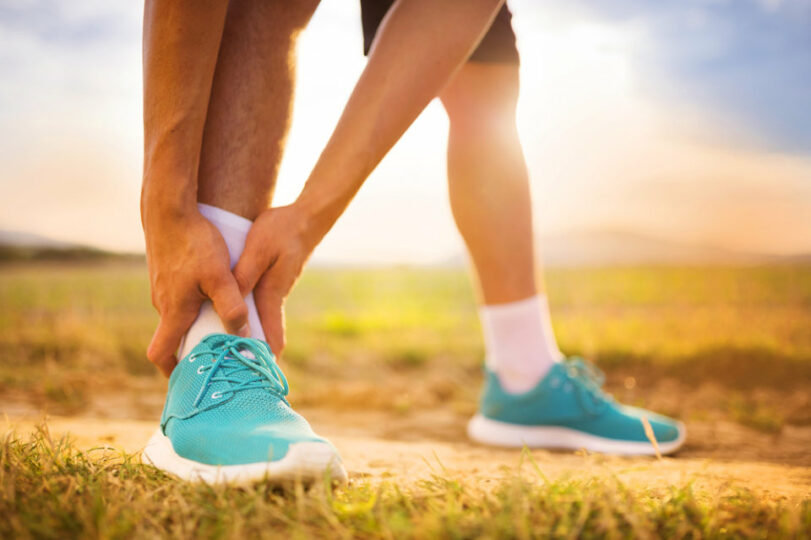Running offers some pretty amazing health benefits. In addition to improving cardiovascular health and building strong muscles, it has also been proven to increase bone density, strengthen the immune system, decrease insulin resistance, mitigate the effects of stress, and even aid spine health.
So, if you’ve ever looked at the advantages of daily jogging, you might have thought to yourself: “I should be doing more of this.”
But here’s the truth: too much of a good thing is bad enough. Not only are running injuries common (both amongst beginner and experienced runners), but they can be pretty serious too.
These afflictions can impact more than just the number of miles you log every week. Much more worryingly, a single running injury can seriously affect your day-to-day life, comfort levels, and even your ability to work out at all.
So how do you prevent and heal the most common running injuries? Well, it turns out that just a few precautions could help you keep you ensure the longevity of your running career.
Common Running Injuries to Look Out For
Before we get into the best ways to prevent most running injuries, it’s not a bad idea to get yourself acquainted with the hurts and damages most runners face over the course of their running careers.
Plantar Fasciitis
An ailment that typically manifests as an intense stabbing pain in the heel, plantar fasciitis is caused by an inflamed tendon in the foot.
Because tension and stress (such as that inflicted by running) cause the tendon to become stretched (or even cause micro-tears), this condition gets worse when left untreated, which is why prevention and a proper healing regime are essential.
Heel Spurs
These are, basically, calcium deposits on the underside of the heel bone caused by excessive strain on the feet.
They often cause chronic pain that’s particularly uncomfortable when jogging and running. When left untreated, heel spurs may cause the surrounding tissue to become inflamed, which can cause sharp pain. Fortunately, some rest and a good pair of cushioning footwear can prevent the issue from becoming too severe and requiring an operation.
Achilles Tendinitis
An overuse injury of the Achilles tendon is one of the most common injuries runners suffer. Especially if they suddenly increase the intensity or duration of their runs.
Luckily, both treatment and prevention can be relatively simple — as long as they’re applied promptly.

Shin Splints
Caused by tissue inflammation of the muscles and tendons surrounding the tibia, shin splints are commonly experienced by runners and athletes.
As with Achilles tendinitis, the great thing about shin splints is that they are relatively easy to treat with rest, stretching, compression, and ice.
Runner’s Knee
Being one of the more serious injuries commonly experienced by runners, runner’s knee (or Patellofemoral Pain Syndrome) is a dull pain caused by overuse, structural defects, or deterioration of the knee cartilage.
Unfortunately, the effectiveness of treating runner’s knee depends on the underlying cause. Sometimes, simple rest and icing will be enough. Other times, weight loss, targeted muscle strengthening, or even more invasive treatment methods will be required to manage the pain.

IT Band Syndrome
IT band syndrome is another overuse injury that affects the knee area. Moreover, IT band syndrome is an inflammation that can get progressively worse when left untreated.
Its symptoms include pain at the back of the knee, snapping and popping of the kneecap, and (sometimes) a radiating discomfort that extends to the thigh or hip.
Stress Fracture
Finally, some of the most serious injuries runners suffer from include stress fractures, which are basically small bone cracks caused by overuse.
They often manifest as pain and swelling that worsens with time. When they don’t heal properly, they can cause chronic problems. This is why it’s essential to take care of this injury and take the time to ensure it’s 100% cured before going back to running.
Tips for Preventing & Healing Common Running Injuries
Now that you know what common running injuries to look out for, it’s time to talk about prevention and healing.
Naturally, each of these conditions will have specific prevention and treatment plans. However, the truth is that a routine that prioritizes your wellbeing will suffice to stop you from ever having to deal with these conditions in the first place.
And the great thing is, there are just a few practices you have to add to your daily running routine to ensure your dreams are never stopped from coming true.
Prioritize Rest & Recovery
While it may be the simplest prevention method on this list, rest somehow seems to be the most challenging piece of advice for runners and athletes to follow.
You see, recovery is essential for ensuring optimum performance and physical health. So don’t fail to do your stretches, foam roll after your run, take at least one day off from jogging per week (do some yoga instead), and get enough sleep.
Yes, all of these may seem like pretty basic tips. However, they’re sure to help you prevent common overuse injuries and heal the ones you have faster.
Change Your Shoes Regularly
You don’t have to spend hundreds of dollars on running shoes. However, you must ensure that the pair you’re actively using serves you well.
A great tip to help your running shoes last longer is to always have two pairs that you alternate between. This allows the insides to properly dry, thus maximizing the lifespan of each pair of runners. Of course, as soon as you start feeling the outsoles lose their grip, the insoles flatten, or the cushioning give out, get a new pair.
You don’t necessarily have to throw them out. However, keep in mind that they’ll have lost their protective power and that if you wish to avoid injury, you’re better off investing in new kicks.
(If you’re still not convinced that you need to change shoes regularly, simply compare the cost of an affordable mid-range pair of running shoes with the cost of medical treatment. The math is pretty straightforward.)
Improve Your Form
Sometimes, even experienced runners make technical mistakes. After all, jogging and running are types of exercise most people take up on their own. So, it’s only natural that they have created some poor habits, especially when it comes to technique.
Now, you may be thinking: what does my form matter if I’m not in any pain right now? Well, the thing is, landing on the wrong part of your foot, overstriding, or hunching while you run can all cause injury. Especially if it’s happening several times per week for months or years on end.
Fortunately, you can actively work on improving your form even if you’ve adopted poor technique over the years. This guide is a great start, so give it a read and try implementing the advice into your daily routine.

Know Your Body and Your Limits
Finally, if your goal is to prevent common running injuries (or speed up the healing process if you’re currently suffering from one), the best thing you can do is listen to your body.
Something as simple as figuring out your limits — physical and mental — will be impactful in allowing you to achieve your goals.
For example, if you know that you have short hamstrings, you can expect your running to be negatively impacted. Fortunately, however, you can take the time to actively focus on stretching so that you mitigate injury risk and allow yourself to improve your results.
Or, if you know that you’re prone to pushing yourself too hard, something as simple as coming up with a training schedule may help you avoid overexertion and overuse injuries.
Final Thoughts
As you can guess, getting injured isn’t uncommon amongst runners. In fact, up to 70% of recreational and competitive runners sustain an injury every year.
But, the great thing is, you can do quite a lot to prevent serious mishaps as well as to ensure you bounce back as quickly as possible.
Of course, the tips covered in this article are just a start. If you wish to ensure you’re in the shape of your life, the best thing you can do is seek out a professional and experienced coach who can guide you on your journey by prioritizing your health while helping you achieve your goals.





